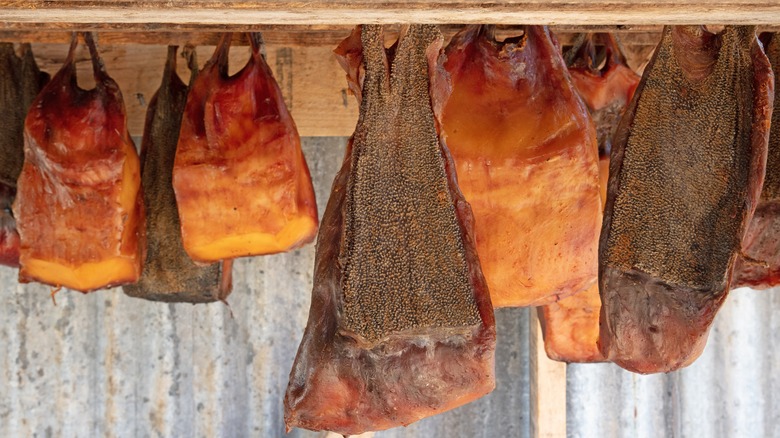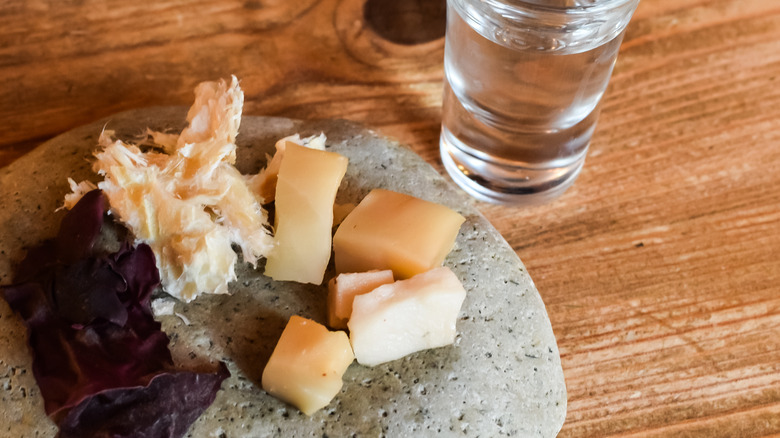What Is Hákarl, And Is It Safe To Eat?
What brave human first cracked open a lobster? How did indigenous Central Americans first learn to nixtamalize corn to access its nutrients, making masa and tortillas an important staple? Who first cooked a nettle to neutralize the sting? And who, how, when, and why did Icelanders start burying sharks to make them, well, generally edible?
Maybe you've heard of fermented shark, an Icelandic delicacy. This is hákarl. Often served in cubes or small chunks with a pale, creamy yellow interior and darker rind, it looks a bit like parmesan or smoked gouda. It does not, however, taste like these pleasant, nutty cheeses. It is a shock to the senses that Gordon Ramsey quickly spit out on television. As The Wall Street Journal notes, Anthony Bourdain once said hákarl was the "single worst, most disgusting and terrible tasting thing" he had ever eaten.
And yet, in the sometimes inhospitable climate of Iceland, hákarl is celebrated as a heritage food and featured in the midwinter Þorrablót festival every year. Locals truly enjoy watching tourists torture themselves with a taste of the fermented meat, and facing this delicacy is a must-do activity for brave visitors to the island. If made improperly, though, it's not just unpalatable — it can be quite toxic.
How hákarl is made
Hákarl was traditionally made as a method of preserving valuable meat. In order to make the poisonous meat of the Greenland shark edible, as explained in a 2019 paper titled "Unveiling hákarl: A study of the microbiota of the traditional fermented Icelandic fish" published in Food Microbiology, it first must be thoroughly fermented for three to six weeks. Historically, this happened in pits dug into the sand near the ocean. The meat would be placed into the pits and covered with stones, seaweed, and turf, and they'd often be covered with seawater at high tide. In modern times, this stage happens in closed containers that allow the drainage of the liquid resulting from the fermentation process.
After the meat has fermented, it is hung to dry age for three to six months more, depending on the environmental conditions. This process neutralizes the toxins in the hákarl. The meat from the body of the shark is generally softer, whiter, and has a more cheese-like texture; the belly meat is redder and chewier. It's a somewhat gelatinous meat with a stench of ammonia on the nose and features a taste of strong blue cheese with a finish of urine. Well-made hákarl might be hard to stomach, but bad hákarl can cause some pretty serious side effects.
What happens if you eat bad hákarl?
Sharks do not have a urinary tract. Instead, they filter and store what would be waste in humans in their blood and flesh as necessary chemical balancers for osmotic pressure. This process allows sharks to maintain important saline levels in their skin to balance the salinity of their environment — that is, the sea. Due to this, shark meat is imbued with high levels of urea and trimethylamine oxide.
These chemicals keep the shark alive in the frigid waters around Iceland, but are highly dangerous to humans. According to the Canadian Institute of Food Safety, even just a few bites of uncured meat can cause severe food poisoning, with intestinal distress, neurological effects, and convulsions being some of the acute symptoms. If eaten in large enough quantities, uncured or improperly cured hákarl can cause death.
Most Icelandic hákarl is now made under the watchful eye and know-how of the Bjarnarhöfn Shark Museum. Visitors can go tour the museum to learn about the history and process up close, try the meat if they dare, and trust that their hákarl is being made safely.


